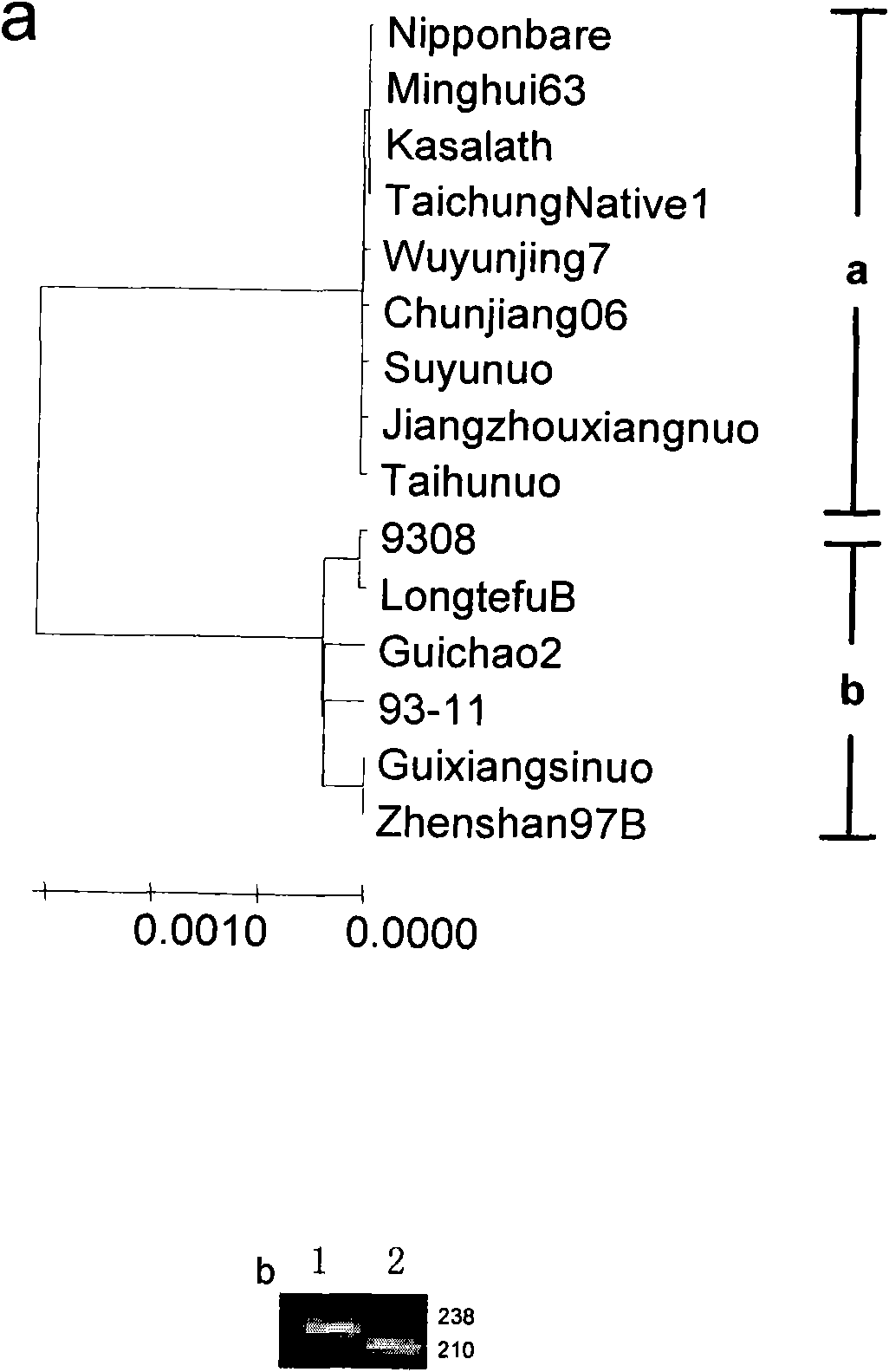Molecular marker of gene for regulating gel consistency of rice and application thereof
A technology of glue consistency and rice is applied in the field of rice glue consistency regulation gene molecular markers, which can solve the problem of less molecular markers and the like
- Summary
- Abstract
- Description
- Claims
- Application Information
AI Technical Summary
Problems solved by technology
Method used
Image
Examples
Embodiment 1
[0035] Embodiment 1, the design and application of Wx molecular marker
[0036] The 15 varieties of rice were obtained from the Rice Research Institute of the Chinese Academy of Agricultural Sciences. The rice gel consistency of 15 varieties of rice was detected by the method provided by the "Rice Quality Determination Standards of the Ministry of Agriculture of the People's Republic of China". After clustering, based on Wx (GENBANK ACCESSION NO.GQ151053), 15 rice varieties can be divided into 3 genotypes (see figure 1 -a). Type III is a cultivar of glutinous rice. After sequencing, it was found that there was a 23bp repeat sequence insertion in glutinous rice, which led to the early termination of the gene, which is why the GC value of glutinous rice is higher (the average value is 91.47). Type II cultivars had low GC values (the average value was 39.55), and type I cultivars had moderate GC values (the average value was 61.59). The gel consistency and Wx gene-based ge...
Embodiment 2
[0043] Embodiment 2, the design and application of AGPso molecular marker
[0044] After clustering, 15 rice varieties can be divided into five genotypes based on AGPiso genes (see figure 2 -a). Under the same Wx genotype background, type a had slightly higher GC value than other genotypes. The rice gel consistency and genotypes based on Wx and AGPiso genes of different rice varieties are shown in Table 3.
[0045] Table 3 Rice gel consistency of rice varieties based on Wx and AGPiso genotypes
[0046]
[0047]
[0048] Using the genomic DNA of rice as a template, carry out PCR amplification with the marker AGPisoM1, digest the PCR amplification product with restriction endonuclease BstXI, perform electrophoresis on the digested product and sequence the PCR amplification product (verify the electrophoresis result), The varieties of type b and type c obtained DNA fragments of 913bp, 536bp and 377bp, and the varieties of type a, type d and e obtained DNA fragments of 5...
Embodiment 3
[0051] Embodiment 3, the design and application of SBE3 molecular marker
[0052] After clustering, based on the SBE3 gene (GENBANK ACCESSION NO.GQ150913), 15 rice varieties can be divided into two genotypes (see image 3 -a). Type a includes 9 varieties including Nipponbare, type b includes 6 varieties including 93-11. Under the background of the same Wx genotype, the average GC of type a was slightly higher than that of type b. The rice gel consistency of different rice varieties and genotypes based on Wx and SBE3 genes are shown in Table 4.
[0053] Table 4 Rice gel consistency of rice varieties based on Wx and SBE3 genotypes
[0054]
[0055]
[0056] Genomic DNA of rice was used as a template, PCR amplification was carried out with the marker SBE3M1, and the PCR amplification product was subjected to electrophoresis and sequenced to verify the electrophoresis results. The type a variety obtained a 238bp DNA fragment, and the type b variety obtained a 210bp DNA fr...
PUM
 Login to View More
Login to View More Abstract
Description
Claims
Application Information
 Login to View More
Login to View More - R&D
- Intellectual Property
- Life Sciences
- Materials
- Tech Scout
- Unparalleled Data Quality
- Higher Quality Content
- 60% Fewer Hallucinations
Browse by: Latest US Patents, China's latest patents, Technical Efficacy Thesaurus, Application Domain, Technology Topic, Popular Technical Reports.
© 2025 PatSnap. All rights reserved.Legal|Privacy policy|Modern Slavery Act Transparency Statement|Sitemap|About US| Contact US: help@patsnap.com



